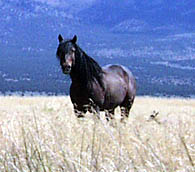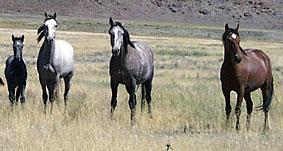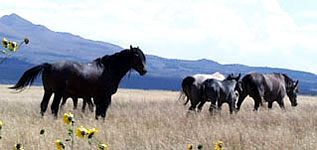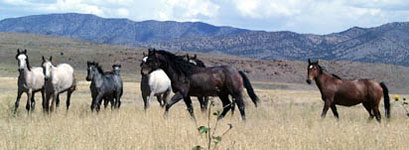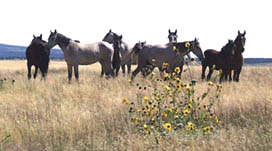 |
|
Mustang
Horses were brought
to North America hundreds of years ago. The wild horses we see today
are descendants of horses that escaped or were left behind. Mustangs
are wild horses.
|
-
What
does a mustang look like?
- Since they live in the wild, mustangs
look pretty dirty. They often have scars. You can find many different
colors of horses in a herd. Over half of the horses are reddish brown.
You can also find grey, black, white, and tan colors. A pinto has
a mix of colors.
|
|
|
|
|
|
|
|
|
|
- Male leaders are called stallions. They
can be up to five feet tall and weigh 1000 pounds.
-
- Baby horses are called foals. It
takes 11 months for a foal to be born.
-
- In
their second year, a male is called a colt. A female is called a filly.
They are also called yearlings. It takes four to seven years for a
colt to become full grown.
|
|
|
|
|
|
|
|
|
|
|
|
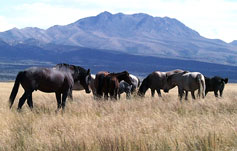 |
|
- What do mustangs
eat?
- Wild horses eat grass and other plants.
They drink water from seeps, springs, streams, or lakes. Adults eat
about 5 to 6 pounds of plant food each day.
|
|
|
|
|
|
|
|
|
|
- Each band of horses has a lead female
called a mare. The mare leads the family to food and water.
-
-
- Where can I find
a mustang?
- Wild horses may roam many miles to find
food, water, and shelter. Most wild horses live on public lands in
the western United States.
-
-
Wild
horses stay together for protection. The
stallion is the leader and usually stays in back of the band. In
the photos below, the stallion is in front of his band for protection.
-
-
-
- Who are the friends
and enemies of a mustang?
- Wolves and coyotes aren't
big enough to kill a wild horse. Mountain
lion and black
bear can kill sick and
weak horses. Horses escape
their enemies by herding and running.
-
- Humans are both friends and enemies
of mustangs.
|
|
|
|
|
|
|
|
|
|
|
Today there are less than 20 thousand wild horses
roaming public lands. The government says that the land can only handle
about 24 thousand horses. Other people think that continuing to decrease the horse
population will lead to extinction.
A wild
horse adoption program lets people adopt
a horse.
|
|
|
|
|
|
|
|
|
|
|
|
|
More Information
-
Note: All photographs
taken with a digital camera near the Onaqui Mountain Wild Horse Management
Area along the Pony Express Trail National Back Country Byway in Utah.
(September 1999).
Developed
by Annette Lamb
and Larry Johnson,
6/99, Updated 4/02.
|

